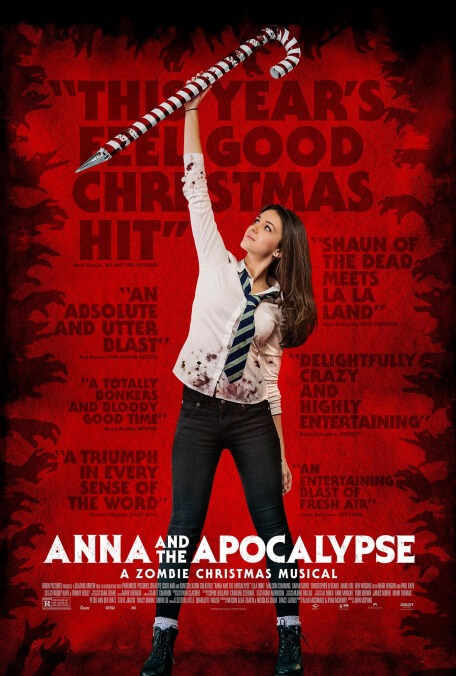Anna And The Apocalypse is a holiday-horror cocktail of singing, maiming, and clichés

John McPhail’s horror-comedy-musical Anna And The Apocalypse seems like an easy sell for a new crop of genre fans raised on the pop tunes and twee melodrama of High School Musical. The film stars a host of young unknowns with bright, clear voices, mostly untarnished by any hint of personality, though that exuberant blandness is kind of on-key for what McPhail’s attempting: a parody of teen-angst dramas and the Disney-fied singing of contemporary pop. Unfortunately, the film, written by Alan McDonald from a short by the late Viner Ryan McHenry, at times comes closer to a facsimile than a parody. When McPhail does hit the high notes, however, he really hits them.
Anna (Ella Hunt) leads a semi-charmed high school life—she’s beautiful and smart and loved, but still a Pretty In Pink-style heroine with a widowed janitor father who doesn’t get her big hopes and dreams. Of course, Anna’s best bud, John (Malcolm Cumming), harbors a secret crush on her, which is indicative of the lazier, more derivative portions of the story that simply repeat tropes rather than comment on them. But this pair at least offers one perfectly lovely duet that plays out while the two sing and dance about their small Scottish town, celebrating the “beautiful day” with exclamation points in their voices. Both have ears plugged with earbuds, delightfully oblivious to the mayhem and destruction unfolding in the background of every shot: fire, car crashes, brain-hungry zombies! (It’s an effective gag, even if it’s been done before, best in Shaun Of The Dead.) When Anna and John finally break out of their self-centered bubbles to the shock that they must battle to the death an undead neighbor in a giant snowman costume, it plays like a poignant comment on movie teenagers’ tendency to indulge their inner lives, ignorant of the world around them. The juxtaposition of big, throaty harmonies to bloody murder on a quiet, hillside playground overlooking a cemetery provides a jolt of frictious hilarity.
Although Anna isn’t particularly ho-ho-ho funny, McPhail earns a few more solid laughs through the character of Lisa (Marli Siu), who’d probably have gotten voted Most Likely To Become A Star if her classmates had lived long enough to fill out their ballots. For a school Christmas pageant, Lisa croons explicitly detailed and euphemistic lyrics about unloading Santa’s sack in the style of “Santa Baby,” only funnier because Lisa’s so absolutely self-assured that no aghast look from an adult can faze her. The crude comedy here doesn’t necessarily fit the tone of the remainder of the film, but it is the most dynamic, subversive bit in a movie where one song is often indistinguishable from the next.
What’s tiresome about Anna, though, is that it’s such an obvious mashup of other movies, moving from homage right into ripoff. At any point of the film, it’s possible to say, “Oh, it’s like [fill in the blank].” La La Land? Check. John Hughes classics? Double check. Buffy The Vampire Slayer, Crazyhead, Oliver!, Mean Girls? Yes. All of it. If it was popular in the horror/teen/musical canon, it’s here. That’s not to say McPhail doesn’t impress with his technical execution. With a low budget and limited resources, he’s able to expertly mimic the styles of bigger productions, as in a cafeteria number featuring students dancing and stomping on the tables with tricky Broadway-friendly choreography provided by Sarah Swire, who also plays Steph, a wise-cracking, world-weary American kid abandoned by her wealthy parents.
Helping McPhail along is cinematographer Sara Deane, whose wide-angle framing and moody, textured lighting counters the flatter elements. Thanks to the camerawork, costuming, and production design, every shot is a carefully composed portrait, every inch of the frame occupied by an object, fabric, or shadow that informs the characters or narrative. Sure, most of the music and story is dead, but the heart of Anna And The Apocalypse is in its execution.